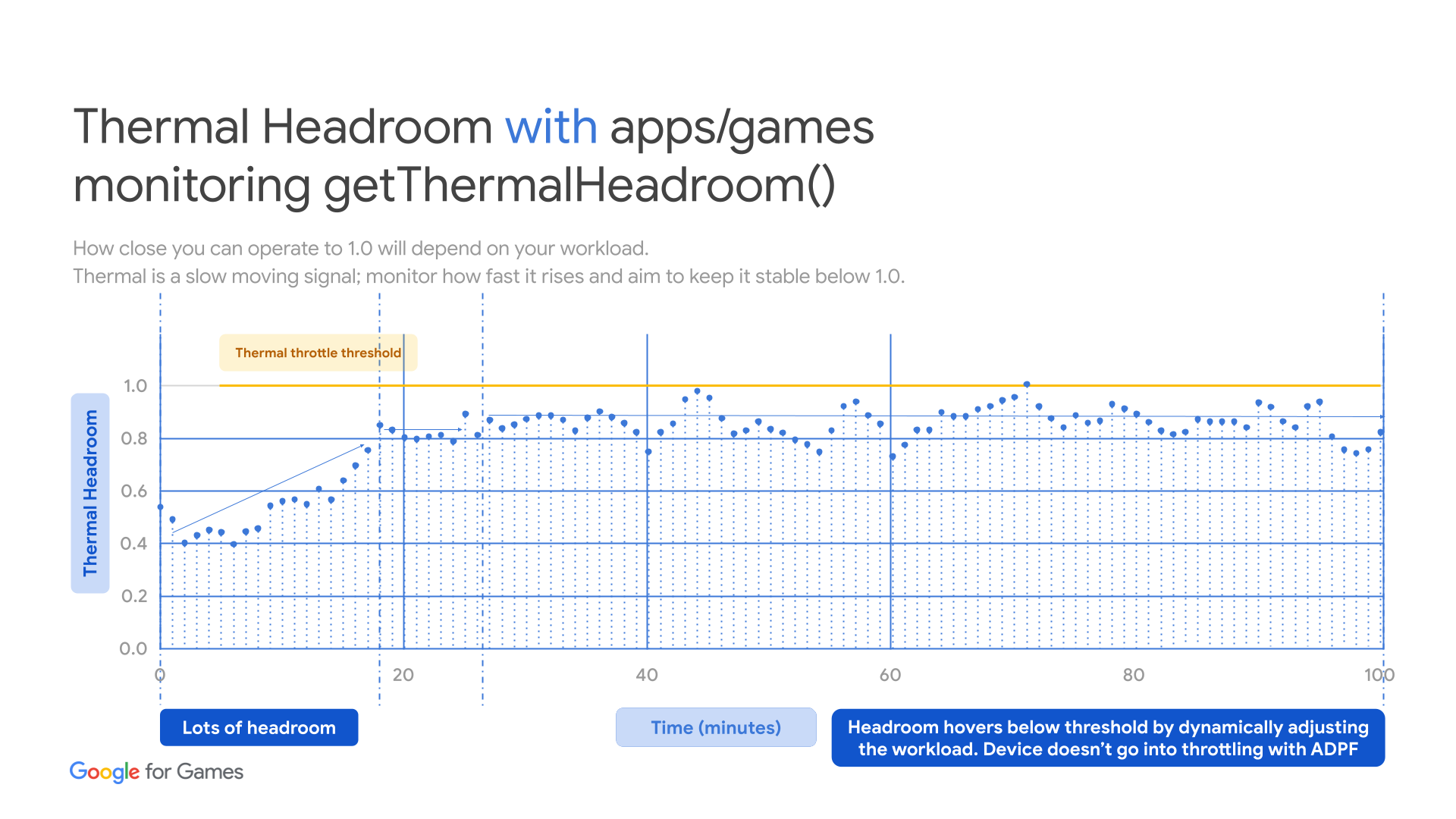已发布:
Android 11 (API Level 30) - Thermal API
Android 12 (API Level 31) - NDK API
(预览版) Android 15 (DP1) - getThermalHeadroomThresholds()
应用的潜在性能受设备热状态的限制,这可能因天气、近期使用情况和设备散热设计等特征而异。设备只能在有限的时间内保持高水平性能,之后就会因散热问题而受到限制。您的实现的一个关键目标是,在不超出散热限制的情况下实现性能目标。Thermal API 使这成为可能,无需针对特定设备进行优化。此外,在调试性能问题时,了解设备的热状态是否限制了性能非常重要。
游戏引擎通常具有运行时性能参数,可以调整引擎施加到设备上的工作负载。例如,这些参数可以设置工作线程数、大小核的工作线程亲和性、GPU 保真度选项和帧缓冲区分辨率。在 Unity 引擎中,游戏开发者可以使用 Adaptive Performance 插件更改 质量设置来调整工作负载。对于 Unreal Engine,请使用可伸缩性设置来动态调整质量级别。
当设备接近不安全的热状态时,您的游戏可以通过这些参数降低工作负载,从而避免受到限制。为避免限制,您应监控设备的热状态,并主动调整游戏引擎工作负载。一旦设备过热,工作负载必须降至可持续的性能水平以下,以便散热。在散热余量降至更安全的水平后,游戏可以再次提高质量设置,但请务必找到一个可持续的质量水平以实现最佳游戏时长。
您可以通过轮询 getThermalHeadroom 方法来监控设备的热状态。此方法会预测设备在不过热的情况下可以维持当前性能水平的时长。如果时间少于运行工作负载所需的时间,那么您的游戏应将工作负载降低到可持续的水平。例如,游戏可以切换到较小的核心、降低帧速率或降低保真度。


获取 Thermal Manager
要使用 Thermal API,首先您需要获取 Thermal Manager。
C++
AThermalManager* thermal_manager = AThermal_acquireManager();
Java
PowerManager powerManager = (PowerManager)this.getSystemService(Context.POWER_SERVICE);
提前 x 秒预测散热余量以进行更多控制
您可以要求系统根据当前工作负载提前 x 秒预测温度。这为您提供了更精细的控制,以及更多时间通过减少工作负载来防止热节流生效,从而做出反应。
结果范围从 0.0f(无节流,THERMAL_STATUS_NONE)到 1.0f(严重节流,THERMAL_STATUS_SEVERE)。如果您的游戏有不同的图形质量级别,您可以遵循我们的散热余量指南。
C++
float thermal_headroom = AThermal_getThermalHeadroom(10);
ALOGI("ThermalHeadroom in 10 sec: %f", thermal_headroom);
Java
float thermalHeadroom = powerManager.getThermalHeadroom(10);
Log.d("ADPF", "ThermalHeadroom in 10 sec: " + thermalHeadroom);
或者,依靠热状态进行说明
每个设备型号的设计可能不同。有些设备可能能够更好地散热,因此在受到限制之前能够承受更高的散热余量。如果您想读取散热余量范围的简化分组,可以检查热状态以理解当前设备上的散热余量值。
C++
AThermalStatus thermal_status = AThermal_getCurrentThermalStatus(thermal_manager);
ALOGI("ThermalStatus is: %d", thermal_status);
Java
int thermalStatus = powerManager.getCurrentThermalStatus();
Log.d("ADPF", "ThermalStatus is: " + thermalStatus);
在热状态更改时收到通知
您还可以避免轮询 thermalHeadroom,直到 thermalStatus 达到某个级别(例如:THERMAL_STATUS_LIGHT)。为此,您可以注册回调,让系统在状态更改时通知您。
C++
int result = AThermal_registerThermalStatusListener(thermal_manager, callback);
if ( result != 0 ) {
// failed, check whether you have previously registered callback that
// hasn’t been unregistered
}
Java
// PowerManager.OnThermalStatusChangedListener is an interface, thus you can
// also define a class that implements the methods
PowerManager.OnThermalStatusChangedListener listener = new
PowerManager.OnThermalStatusChangedListener() {
@Override
public void onThermalStatusChanged(int status) {
Log.d("ADPF", "ThermalStatus changed: " + status);
// check the status and flip the flag to start/stop pooling when
// applicable
}
};
powerManager.addThermalStatusListener(listener);
完成后请记住移除监听器
C++
int result = AThermal_unregisterThermalStatusListener(thermal_manager, callback);
if ( result != 0 ) {
// failed, check whether the callback has been registered previously
}
Java
powerManager.removeThermalStatusListener(listener);
清理
完成后,您需要清理已获取的 thermal_manager。如果您使用的是 Java,PowerManager 引用可以由系统自动进行垃圾回收。但是,如果您通过 JNI 使用 Java API 并且保留了引用,请记住清理引用!
C++
AThermal_releaseManager(thermal_manager);
有关如何在原生 C++ 游戏中使用 C++ API (NDK API) 和 Java API(通过 JNI)实现 Thermal API 的完整指南,请参阅 Adaptability codelab 部分中的“集成 Thermal API”部分。
散热余量指南
您可以通过轮询 getThermalHeadroom 方法来监控设备的热状态。此方法会预测设备在达到 THERMAL_STATUS_SEVERE 之前可以维持当前性能水平的时长。例如,如果 getThermalHeadroom(30) 返回 0.8,则表示在 30 秒内,余量预计将达到 0.8,距离严重节流(即 1.0)还有 0.2。如果时间少于运行工作负载所需的时间,那么您的游戏应将工作负载降低到可持续的水平。例如,游戏可以降低帧速率、降低保真度或减少网络连接工作。
热状态及其含义
- 如果设备未受到散热限制
- 存在一定限制,但对性能无显著影响
- 对性能有显著影响的限制
Thermal API 的设备限制
由于较旧设备上的 Thermal API 实现,存在一些已知的 Thermal API 限制或额外要求。限制及其解决方法如下:
- 不要过于频繁地调用
GetThermalHeadroom()API。如果这样做,API 将返回NaN。您调用它的频率不应超过每 10 秒一次。 - 避免从多个线程调用,这会更难确保调用频率,并可能导致 API 返回
NaN。 - 如果
GetThermalHeadroom()的初始值为 NaN,则设备上不可用该 API - 如果
GetThermalHeadroom()返回高值(例如:0.85 或更高),并且GetCurrentThermalStatus()仍然返回THERMAL_STATUS_NONE,则状态可能未更新。请使用启发式方法来估计正确的散热节流状态,或者仅使用getThermalHeadroom()而不使用getCurrentThermalStatus()。
启发式示例
- 检查是否支持 Thermal API。
isAPISupported()会检查对getThermalHeadroom的首次调用的值,以确保它不为 0 或 NaN;如果首次调用值为 0 或 NaN,则跳过使用该 API。 - 如果
getCurrentThermalStatus()返回的值不是THERMAL_STATUS_NONE,则设备正在受到散热限制。 - 如果
getCurrentThermalStatus()持续返回THERMAL_STATUS_NONE,这不一定表示设备未受到散热限制。这可能意味着设备不支持getCurrentThermalStatus()。请检查getThermalHeadroom()的返回值以确保设备状况。 - 如果
getThermalHeadroom()返回的值 > 1.0,则实际状态可能为THERMAL_STATUS_SEVERE或更高,请立即减少工作负载并保持较低工作负载,直到getThermalHeadroom()返回较低值 - 如果
getThermalHeadroom()返回 0.95,则实际状态可能为THERMAL_STATUS_MODERATE或更高,请立即减少工作负载并保持警惕以防止更高的读数 - 如果
getThermalHeadroom()返回 0.85,则实际状态可能为THERMAL_STATUS_LIGHT,请保持警惕并在可能的情况下减少工作负载
伪代码
bool isAPISupported() {
float first_value_of_thermal_headroom = getThermalHeadroom();
if ( first_value_of_thermal_headroom == 0 ||
first_value_of_thermal_headroom == NaN ) {
// Checked the thermal Headroom API's initial return value
// it is NaN or 0,so, return false (not supported)
return false;
}
return true;
}
if (!isAPISupported()) {
// Checked the thermal Headroom API's initial return value, it is NaN or 0
// Don’t use the API
} else {
// Use thermalStatus API to check if it returns valid values.
if (getCurrentThermalStatus() > THERMAL_STATUS_NONE) {
// The device IS being thermally throttled
} else {
// The device is not being thermally throttled currently. However, it
// could also be an indicator that the ThermalStatus API may not be
// supported in the device.
// Currently this API uses predefined threshold values for thermal status
// mapping. In the future you may be able to query this directly.
float thermal_headroom = getThermalHeadroom();
if ( thermal_headroom > 1.0) {
// The device COULD be severely throttled.
} else if ( thermal_headroom > 0.95) {
// The device COULD be moderately throttled.
} else if ( thermal_headroom > 0.85) {
// The device COULD be experiencing light throttling.
}
}
}
图表

